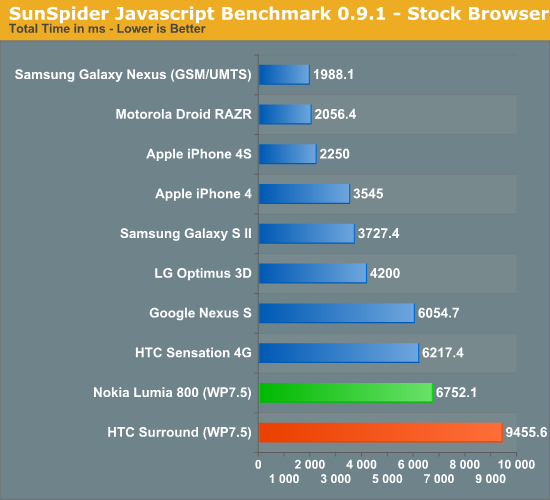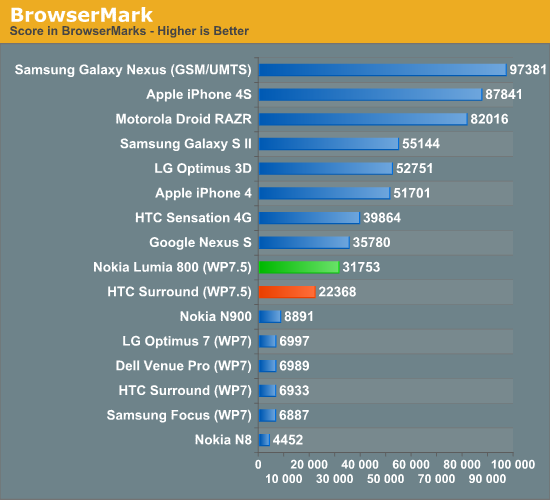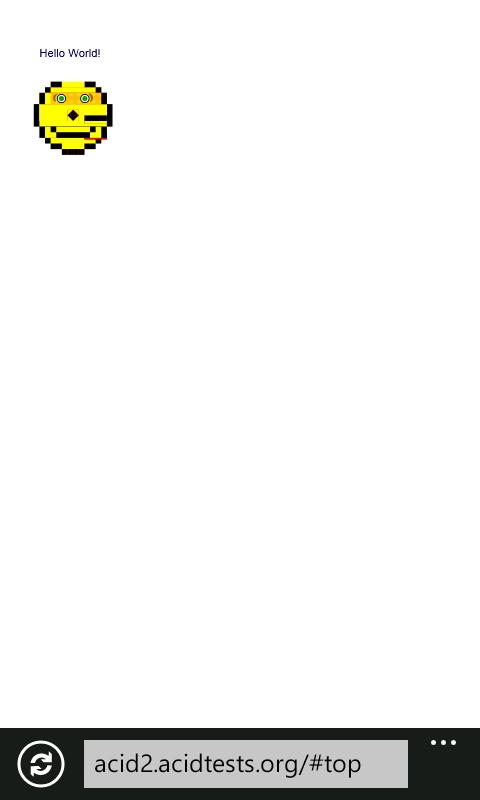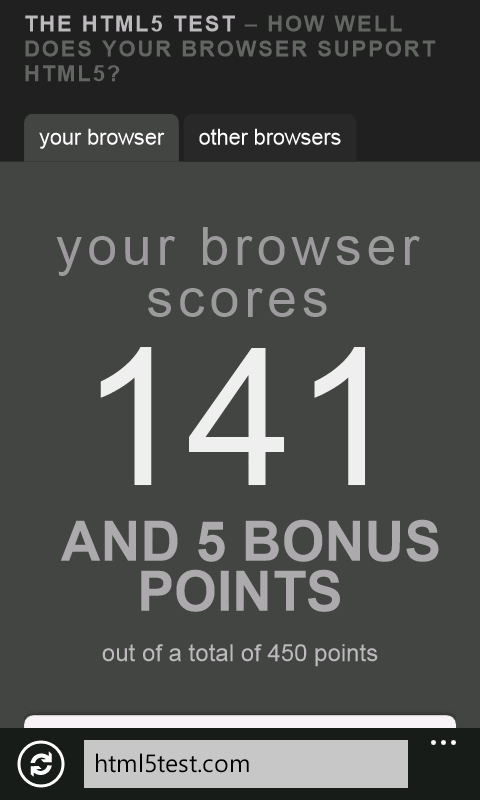Nokia Lumia 800 Review - Nokia's Brave New Foray into WP7
by Brian Klug on January 4, 2012 7:00 AM EST- Posted in
- Smartphones
- Nokia
- windows phone 7
- Mobile
- WP7
- Lumia
- Lumia 800
Unfortunately, the majority of benchmarks that usually grace our smartphone reviews don’t yet have WP7 ports or analogs, but there are a still a number of comparisons we can make. To start, the browser-based performance metrics give a good picture within the Windows Phone ecosystem, and likewise with WPbench, created by one of our own readers and on the marketplace.
There’s been a lot written about performance on WP7 already - namely that comparative analysis isn’t as big of a deal as it is on other smartphone platforms, but of course this is more the result of two things. First, Microsoft’s careful curation of their new smartphone platform with hardware requirements; second, availability of native and managed code execution environments. For the most part, you can pick up any WP7 device and have very good expectation of UI smoothness, but that’s not to say there aren’t differences, especially as the platform moves from one generation of Snapdragon SoC to the next, and now possibly even a move to ST-E. Benchmarking WP7 (and by analog, Windows 8) will become a big deal very soon, however, and numerous SoC vendors and big names in the PC benchmarking scene are looking to port to these platforms.
This current refresh of WP7 devices continues to be based around exclusively Qualcomm SoCs, and the Lumias are no exception. Both the 710 and 800 are based around Qualcomm’s MSM8255 single core S2 Snapdragon at 1.4 GHz with Adreno 205 graphics at the core and dual channel LPDDR2 memory interfaces. This is a 45nm part we’ve seen and explored numerous times before, and as a refresher includes the HSPA+ 14.4 baseband onboard.
Anyhow, onward to the numbers. First is sunspider, which we’ve been using for a long while and recently changed from 0.9 to 0.9.1 with. As a result, I’ve had to re-run devices since the numbers aren’t directly comparable. WP7.5 brings a much improved javascript engine which gives it a big boost in scores. I’ve managed to hang onto the HTC Surround (1.0 GHz QSD8250) and Anand has the Focus (also 1.0 GHz QSD8250), which we’ve included as well.

Browsermark hasn’t changed or forced us to re-run things, so we have comparison numbers that show how much difference there is in the browser department in WP7.5.

In the synthetics, WP7.5’s new JavaScript engine (Chakra) with JIT brings perf almost up to modern levels and is a step in the right direction, but it’s still behind iOS and Android. Moving to a higher clocked single core probably does make sense for Windows Phone, especially if IE is single threaded at this point.
For system benchmarking on WP7.5 we have WP Bench, which was created by one of our own readers. The benchmark reports a total score in addition to three sub-scores for CPU, memory, and GPU. My only point of comparison, again, is the HTC Surround.
| WPBench Comparison | ||
| HTC Surround (1.0 GHz QSD8250) | Nokia Lumia 800 (1.4 GHz MSM8255) | |
| Total Score | 59.85 | 91.14 |
| Result Screenshot |
|
|
Browser Performance and Changes
I’ve made a big deal about browsing performance because, for me at least, the stock browser is the one place where performance really must be flawless. OEMs are starting to wake up to the fact that browsing performance makes a huge impact on the overall subjective weighting of a platform’s smoothness, which in turn results in a lot of scrutiny. I’d agree with this assertion as well and toss in a few other things that must be flawless for a platform to feel speedy.
When WP7.5 first started surfacing we took a look at its revamped IE9-based browser which uses Trident 5.0 as opposed to NoDo’s Trident 3.1. Unsurprisingly everything we saw in the emulator applies to the real-world experience with WP7.5 on live devices. Actually things are even a bit better than they were when we played around in the emulator.


The Windows Phone team has made clear several times that they aren’t going to build the browser to any tests but instead real-world page rendering accuracy. That said it’s still worthwhile to take a look at the synthetics. Acid 3 now completes and nearly passes (the boxes in top right subtract some points) where it previously scored below 95. Similarly Acid 2 now is almost flawless. Finally, the HTML5test score increases from 130 to 141 on the Lumia 800 and newer WP7.5 builds, which is a slight but still important difference.

Moving away from Trident 3.1 to 5.0 has made a huge difference on faithful page rendering and eliminated nearly all of the annoying edge cases I saw with previous WP7 smartphones. A number of pages I visit daily back when we did those reviews would render but with a few notable errata, these are now gone completely.
In addition, scrolling performance remains just as speedy as it was before (essentially buttery smooth) as the rendering architecture remains largely the same. We now have all three platforms (WP7.5, iOS, and Android 3.x/4.x) rendering the browser page into a texture that can be translated, clipped, and zoomed with GPU operations. It’s clear that this is the right way to do things to keep the browser UI speedy.
The changes to WP7.5’s browser make (for me at least) the single most notable improvement over NoDo and previous iterations. It’s a huge step forwards in rendering, compliance, and UI, and having that browser experience be as close to perfect as possible is tremendously important.












120 Comments
View All Comments
crispbp04 - Wednesday, January 4, 2012 - link
Steve Jobs already proved that consumers are idiots. the minority of consumers want android. The majority want something that works, is pretty, and is fun to use. This is the definition of Windows Phone 7. Elop is saving Nokia by betting the farm on Microsoft. Who cares if he has to alienate blind android fanboys such as yourself.steven75 - Wednesday, January 4, 2012 - link
The majority of users also want wide access to the software everyone else has, and WP7 still fails hard on this.crispbp04 - Wednesday, January 4, 2012 - link
cite a specific example of a piece of software you use on android or iOS that isn't on the WP7 marketplace.Thermogenic - Wednesday, January 4, 2012 - link
PayPal app. The mobile website is not nearly as nice as the iPhone or Android apps.doobydoo - Saturday, January 7, 2012 - link
Sky Sports app. Only available on iPhone / iPad.Iketh - Wednesday, January 4, 2012 - link
I have all 3 phone OS's in my home. My wife uses the Android and she hates it, as do I. (She started with WP7 and switched because she didn't like it either, but wishes she had it back now.) I'm using the WP7, but it was a hard decision to leave iOS, mainly because of the superior map app. But the WP7's audio and video quality is far superior to iOS. You're too restricted on the .264 profile allowed on iOS for whatever reason.Other than that, as far as software selection available, everyone can find anything they need on all 3 devices. The software selection on WP7 is already robust, and it's only the beginning.
Imagine when x86 hardware meets Windows Phone. I can't wait...
Mitch89 - Friday, January 6, 2012 - link
When you say audio and video quality are you referring to playback? You can easily use apps like AV Player to playback different formats. High def h.264 looks great on the iPhone 4S in AV Player, not to mention it supports a variety of other formats.sprockkets - Wednesday, January 4, 2012 - link
Yeah, that's why Android has the lion's share of the market, cause "nobody" wants it.Right.
Nfarce - Wednesday, January 4, 2012 - link
Exactly, sprockkets. Let these people talk themselves into whatever they want. It's a free market. And nothing makes me laugh better than an Apple or Winphone fangirl calling Droid users fanbois. LMAO. Not only are Droid phones at the top of the sales charts, they are at the top of the performance charts overall (as this article shows). Just let them lie themselves to sleep at night and move on.doobydoo - Saturday, January 7, 2012 - link
The iPhone 4S is at the top of the pile as far as performance goes. That is reality.Secondly - you both miss the point. People tend to only buy Android over iPhone because it's cheaper. If they were both the same price, you could bet that Android would not be the biggest. Of course, Apple has found the sweet spot in pricing so wouldn't want to change.
Thirdly - Android is only bigger because there are more handsets available, from numerous manufacturers, so no one company actually benefits as much as Apple does. Similarly, no one handset is as popular or in demand as the iPhone 4S right now.
Finally - there are so so many VERY cheap and totally incomparable and retro phones which run old and rubbish hardware with old and rubbish versions of Android which bolster the statistics and provide a false impression.